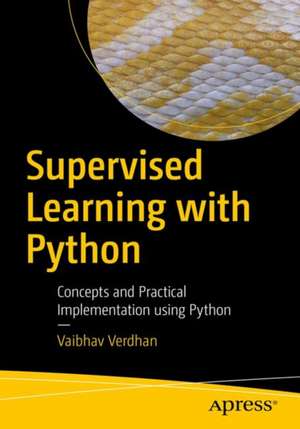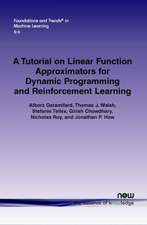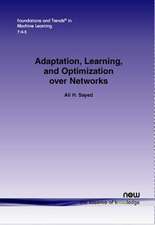Supervised Learning with Python: Concepts and Practical Implementation Using Python
Autor Vaibhav Verdhanen Limba Engleză Paperback – 8 oct 2020
You’ll start with an introduction to machine learning, highlighting the differences between supervised, semi-supervised and unsupervised learning. In the following chapters you’ll study regression and classification problems, mathematics behind them, algorithms like Linear Regression, Logistic Regression, Decision Tree, KNN, Naïve Bayes, and advanced algorithms like Random Forest, SVM, Gradient Boosting and Neural Networks. Python implementation is provided for all the algorithms. You’ll conclude with an end-to-end model development process including deployment and maintenance of the model.After reading Supervised Learning with Python you’ll have a broad understanding of supervised learning and its practical implementation, and be able to run the code and extend it in an innovative manner.
- Review the fundamental building blocks and concepts of supervised learning using Python
- Develop supervised learning solutions for structured data as well as text and images
- Solve issues around overfitting, feature engineering, data cleansing, and cross-validation for building best fit models
- Understand the end-to-end model cycle from business problem definition to model deployment and model maintenance
- Avoid the common pitfalls and adhere to best practices while creating a supervised learning model using Python
Who This Book Is For
Data scientists or data analysts interested in best practices and standards for supervised learning, and using classification algorithms and regression techniques to develop predictive models.
Preț: 263.34 lei
Preț vechi: 329.18 lei
-20% Nou
Puncte Express: 395
Preț estimativ în valută:
50.39€ • 53.88$ • 42.01£
50.39€ • 53.88$ • 42.01£
Carte disponibilă
Livrare economică 27 martie-10 aprilie
Preluare comenzi: 021 569.72.76
Specificații
ISBN-13: 9781484261552
ISBN-10: 1484261550
Pagini: 372
Ilustrații: XX, 372 p. 226 illus., 5 illus. in color.
Dimensiuni: 155 x 235 mm
Greutate: 0.55 kg
Ediția:1st ed.
Editura: Apress
Colecția Apress
Locul publicării:Berkeley, CA, United States
ISBN-10: 1484261550
Pagini: 372
Ilustrații: XX, 372 p. 226 illus., 5 illus. in color.
Dimensiuni: 155 x 235 mm
Greutate: 0.55 kg
Ediția:1st ed.
Editura: Apress
Colecția Apress
Locul publicării:Berkeley, CA, United States
Cuprins
Chapter 1: Introduction to Supervised Learning.- Chapter 2: Supervised Learning for Regression Analysis.- Chapter 3: Supervised Learning for Classification Problems.- Chapter 4: Advanced Algorithms for Supervised Learning.- Chapter 5: End-to-End Model Development
Notă biografică
Vaibhav Verdhan has 12+ years of experience in Data Science, Machine Learning and Artificial Intelligence. An MBA with engineering background, he is a hands-on technical expert with acumen to assimilate and analyse data. He has led multiple engagements in ML and AI across geographies and across retail, telecom, manufacturing, energy and utilities domains. Currently he resides in Ireland with his family and is working as a Principal Data Scientist.
Textul de pe ultima copertă
Gain a thorough understanding of supervised learning algorithms by developing use cases with Python. You will study supervised learning concepts, Python code, datasets, best practices, resolution of common issues and pitfalls, and practical knowledge of implementing algorithms for structured as well as text and images datasets.
You’ll start with an introduction to machine learning, highlighting the differences between supervised, semi-supervised and unsupervised learning. In the following chapters you’ll study regression and classification problems, mathematics behind them, algorithms like Linear Regression, Logistic Regression, Decision Tree, KNN, Naïve Bayes, and advanced algorithms like Random Forest, SVM, Gradient Boosting and Neural Networks. Python implementation is provided for all the algorithms. You’ll conclude with an end-to-end model development process including deployment and maintenance of the model.
After reading Supervised Learning with Python you’llhave a broad understanding of supervised learning and its practical implementation, and be able to run the code and extend it in an innovative manner.
You will:
You’ll start with an introduction to machine learning, highlighting the differences between supervised, semi-supervised and unsupervised learning. In the following chapters you’ll study regression and classification problems, mathematics behind them, algorithms like Linear Regression, Logistic Regression, Decision Tree, KNN, Naïve Bayes, and advanced algorithms like Random Forest, SVM, Gradient Boosting and Neural Networks. Python implementation is provided for all the algorithms. You’ll conclude with an end-to-end model development process including deployment and maintenance of the model.
After reading Supervised Learning with Python you’llhave a broad understanding of supervised learning and its practical implementation, and be able to run the code and extend it in an innovative manner.
You will:
- Review the fundamental building blocks and concepts of supervised learning using Python
- Develop supervised learning solutions for structured data as well as text and images
- Solve issues around overfitting, feature engineering, data cleansing, and cross-validation for building best fit models
- Understand the end-to-end model cycle from business problem definition to model deployment and model maintenance
- Avoid the common pitfalls and adhere to best practices while creating a supervised learning model using Python
Caracteristici
Hands-on approach for implementing supervised learning algorithms like decision tree, RF, SVM, and Neural Nets with Python Cover the mathematics of supervised learning algorithms in a lucid manner Discusses common challenges like overfitting, data imbalance, hyperparameter tuning, outlier treatment

























